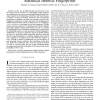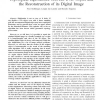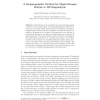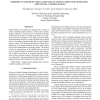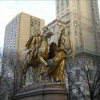94
Voted
TIFS
2010
14 years 11 months ago
2010
—As the use of digital images has increased, so has the means and the incentive to create digital image forgeries. Accordingly, there is a great need for digital image forensic t...
147
click to vote
PAMI
2007
15 years 1 days ago
2007
— Digitization is not as easy as it looks. If one digitizes a 3D object even with a dense sampling grid, the reconstructed digital object may have topological distortions and in ...
94
Voted
DCG
2007
15 years 15 days ago
2007
Weprovethatthegenusoftheboundaryofadigitalimageispreciselyhalfofthe sum of the cycle ranks of three particular graphs: the “foreground graph” and “background graph,” which ...
ICASSP
2010
IEEE
15 years 22 days ago
2010
IEEE
The widespread availability of photo editing software has made it easy to create visually convincing digital image forgeries. To address this problem, there has been much recent w...
100
Voted
SIP
2007
15 years 1 months ago
2007
Digital copyright protection has become increasingly important in recent times due to the rapid growth of the Internet and the proliferation of P2P technologies. Copyright protect...
119
Voted
RT
2004
Springer
15 years 5 months ago
2004
Springer
Pixels store a digital image as a grid of point samples that can reconstruct a limited-bandwidth continuous 2-D source image. Although convenient for anti-aliased display, these b...
105
Voted
ICIAR
2005
Springer
15 years 6 months ago
2005
Springer
Digital images are increasingly being used as steganographic covers for secret communication. The Least Significant Bit (LSB) encoding is one of the most widely used methods for e...
101
click to vote
ICMCS
2007
IEEE
15 years 6 months ago
2007
IEEE
Digital images can be forged easily with today’s widely available image processing software. In this paper, we describe a passive approach to detect digital forgeries by checkin...
101
click to vote
ICASSP
2008
IEEE
15 years 7 months ago
2008
IEEE
Digital images can be captured or generated by a variety of sources including digital cameras, scanners and computer graphics softwares. In many cases it is important to be able t...
ICIP
2004
IEEE
16 years 2 months ago
2004
IEEE
An interesting problem in digital forensics is that given a digital image, would it be possible to identify the camera model which was used to obtain the image. In this paper we l...
